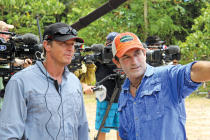Reality Helmers Hail Hands-Off Approach

At a time in reality TV where producers meddle more and more in the lensing of a program, the directors of competition shows are striving to do the opposite: interfere as little as possible once cameras start rolling, and allow contestants duke it out for top prize.
This creates a challenge, however, since unlike scripted series, there are often no second takes in this brand of reality TV. Preparation, then — whether on remote island beaches, Burbank soundstages or Gotham design studios — is crucial.
“When shooting ‘Survivor’ there are no rehearsals,” says host and exec producer Jeff Probst. “Your job is to capture the moments as they happen.”
Gregg Gelfand, director on Fox’s “American Idol” since season seven, says these competition shows offer “very little time to re-shoot anything, and require as much preparation as possible so that when things change (and they always do) you’re not starting from scratch, but rather making adjustments.”
This is a far cry from several cable docu-soaps and docu-comedies that viewers have flocked to in record-breaking droves, where some cast members are hand-fed lines for greenscreen interviews and producers suggest scenarios for cast members to act out, even doing reshoots and dubbing lines in post-production for added drama.
For Bertram van Munster, creator, exec producer and director on CBS’ “The Amazing Race,” preparation for a hands-off approach means scouting and setting up at locations one to three months in advance of the competition’s lensing period.
“I go around the world at least once and look at these locations,” the reality vet explains. “I have all my cameras in place so when we come through for actual challenges, it’s already laid out. When we say ‘go!’ that’s our symbolic ‘action!’ It’s one long take without any interference from us.”
On “Survivor,” prep work means being able to lens on the fly, no matter how daunting the elements.
Probst credits “Survivor’s” director of photography Peter Wery for being “the first one to get in the leech-filled water to shoot an interview,” or climb a tree for a higher camera angle.
“Peter is so committed, he wears a pair of purple knee pads so he can drop to his knees to get a shot without thinking twice.”
Craig Spirko, helmer of Lifetime’s “Project Runway,” says, “As long as we challenge the designers to stretch themselves artistically on the show, there is drama. After that, it’s just a matter of getting the coverage.”
Munster says: “I don’t interfere in reality because that’s what the charm of the show is — I know some producers aren’t, but I’m comfortable turning contestants loose and I think that translates to the audience.
“We don’t know what they’ll be doing next … I think that’s how you need to direct reality TV.”
Related stories
Radio Digs Its Own Grave as Cultural Currents Shift
Showrunner Marc Cherry Has a Song in His Heart
ExecuTech: Keeping Execs Plugged in With Microsoft's Surface Pro Tablet, More
Get more from Variety.com: Follow us on Twitter, Facebook, Newsletter
